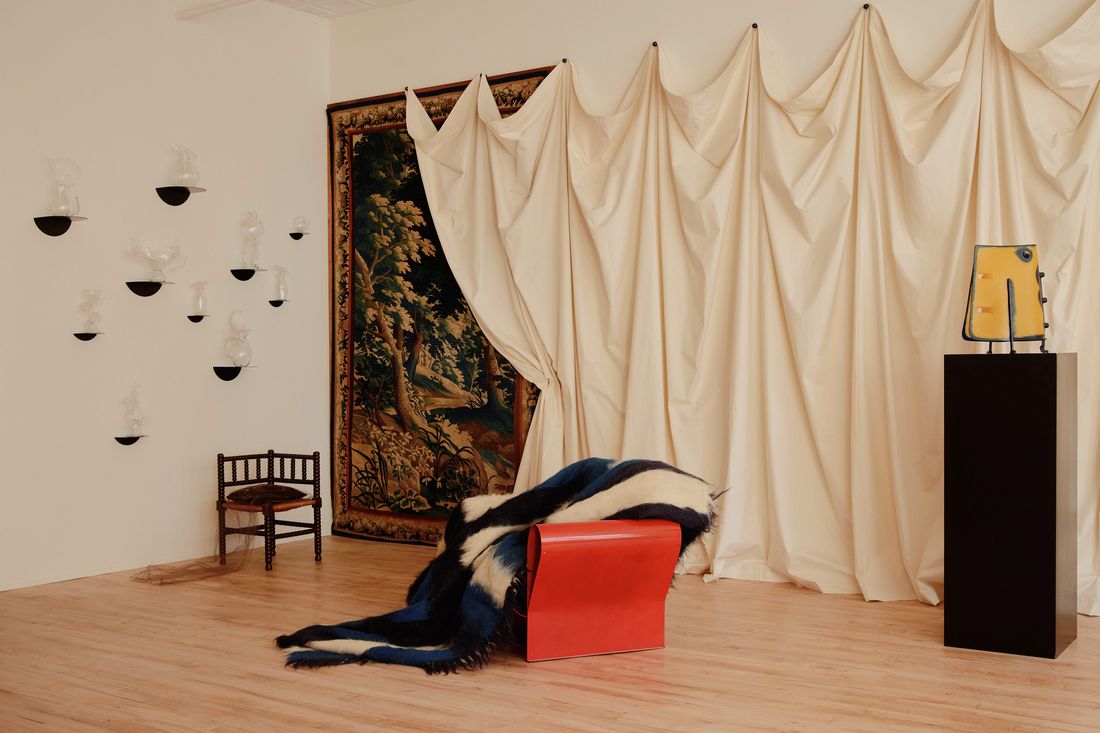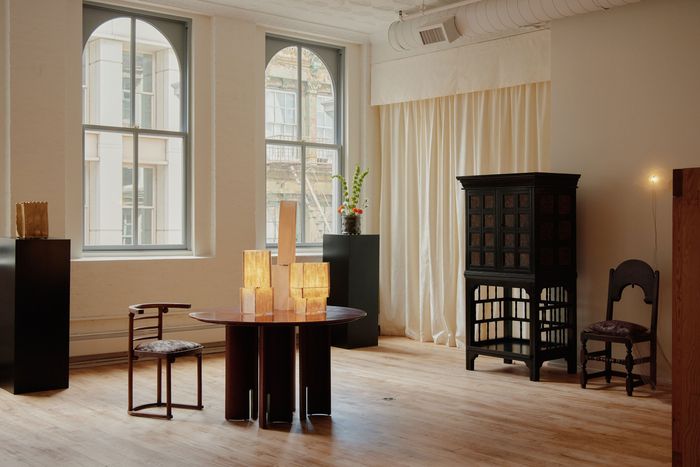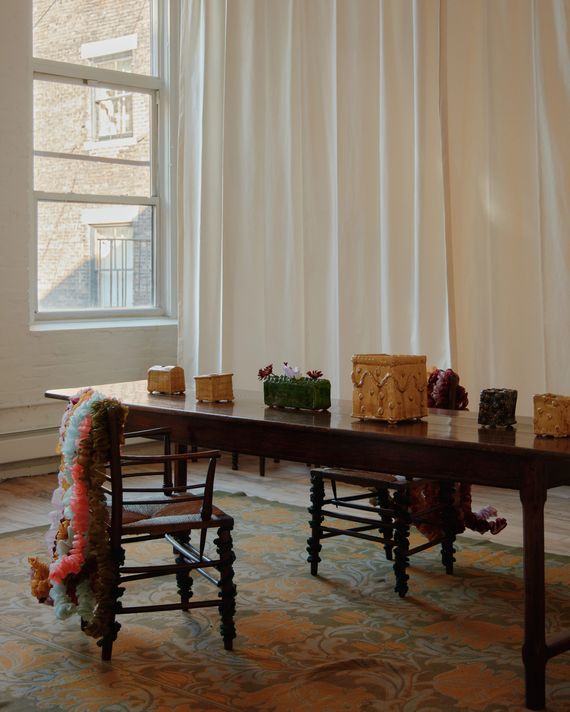
Glass vessels by Valentina Cameranesi Sgroi, a Flemish tapestry, mohair blankets by Grace Atkinson, and a Gaetano Pesce resin lamp are portion of “Substance in a Cushion,” the inaugural exhibition at the Jacqueline Sullivan Gallery.
Image: William Jess Laird
Gertrude Stein’s 1914 reserve, Tender Buttons, starts, “A carafe, that is a blind glass.” She goes on to depict chairs, cushions, and other domestic merchandise and spaces in this experimental, admittedly perplexing prose. The book is typically read as a metaphor for sexual intimacy — including hints of her marriage with Alice B. Toklas — and as a treatise on queer domesticity. Artwork dealer Jacqueline Sullivan took Stein’s reserve as an invitation to conduct a similar work out: to scrutinize the objects we encompass ourselves with right until they come to be unfamiliar and stunning. “Thinking about a chair or glass or these seriously banal items in an practically alien way was exciting to me,” she states. Stein’s poetry, bewildering as it is, “makes you fired up and curious” and inspired “Substance in a Cushion,” the inaugural exhibition at Sullivan’s eponymous Tribeca gallery, which opened this week on the fourth floor of 52 Walker.
Photograph: William Jess Laird
The exhibition, which functions both vintage and new household furniture, encapsulates a 300-yr time span (the oldest piece is a late-17th-century wooden chair from Yorkshire, and the most recent ended up commissioned for the display). For Sullivan, the show represents the “things that I adore all coming together” — significantly less a didactic work out than just one inspired by “what type of feels appropriate.” She worked with the London-centered innovative expert Ruby Woodhouse and vintage-home furniture sourcer Abel Sloane on the assortment, which feels cohesive irrespective of its historic and stylistic selection. All of the merchandise in the display are peers they replicate an extreme devotion to craftsmanship, strategies, and products, regardless of whether it’s a 1970s plywood cabinet by the Belgian brutalist architect Juliaan Lampens or a crimson resin chair by Gaetano Pesce from 2002. As Sullivan writes in a publication accompanying the show, “When I think about furniture and objects, I feel about existence, of gathering, of use … They exist as product that guides us, instructs us, consoles us, and conjures up curiosity and speculate. They become anchors to an or else confusing still wildly expansive human knowledge.”
Jordan McDonald’s ceramic tulipiers, Kristin Dickson-Okuda’s Tendril Sussex chair dressings, and an antique desk from a British monastery.
Photograph: William Jess Laird
For the modern day designers in the exhibition, Sullivan invited them to solution domestic objects the way Stein did. The resulting pieces incorporate extruded-clay tulipieres by Philadelphia-primarily based ceramicist Jordan McDonald that are impressed by industrial stoves, borosilicate-glass carafes shaped like surreal vegetation and sea creatures by the Italian designer Valentina Cameranesi Sgroi, and tactile wax-painted handmade paper lamps by the Danish designers Christian and Jade. But the sensibility of the show is perhaps ideal represented by Kristin Dickson-Okuda’s contribution: She dressed a series of wooden-and-rush chairs created by Philip Webb for William Morris in 1865 with blush-pink silk armrests tied on with extensive black ribbon, slip-on knitted leg warmers, taffeta poufs, and a prolonged veil. Dickson-Okuda — who’s regarded for the Los Angeles boutique Iko Iko and her scrunchielike cord covers — describes it as “clothing that allows the chair manage its existence.” Sullivan also brought a 19th-century Flemish tapestry and Josef Hoffmann chairs from her individual selection, which add to the general working experience of the present as a celebration of handmade design and style.
The modern day objects commissioned for “Substance in a Cushion” consist of the Silk Arm Rest Sussex chair dressing by Kristin Dickson-Okuda, the Glass Incense Holder by Valentina Cameranesi Sgroi, and the Decima textile by Grace Atkinson. Pics: Dan McMahon.
The modern objects commissioned for “Material in a Cushion” include things like the Silk Arm Relaxation Sussex chair dressing by Kristin Dickson-Okuda,…
The modern day objects commissioned for “Substance in a Cushion” consist of the Silk Arm Rest Sussex chair dressing by Kristin Dickson-Okuda, the Glass Incense Holder by Valentina Cameranesi Sgroi, and the Decima textile by Grace Atkinson. Images: Dan McMahon.
The literary and historic inspirations for her initial demonstrate occur from Sullivan’s individual track record: She grew up going to the Brimfield Antique Marketplace with her mom, studied poetry along with design record, and labored at the Cooper Hewitt right before deciding to open her gallery. She desires her place to be for any individual, a put where readers can study about layout heritage and, previously mentioned all, enjoy the objects. As Sullivan walked me by the exhibition, we lingered longest on a 19th-century cabinet built from ebonized wood and adorned with leather panels embossed with a metallic floral sample. It most likely would have been utilised to store a floral arrangement. Hunting at a piece of furniture focused to just that moment of contemplation echoed the knowledge of the gallery itself: as a place that invites us to dwell on exceedingly wonderful, stunning issues.


